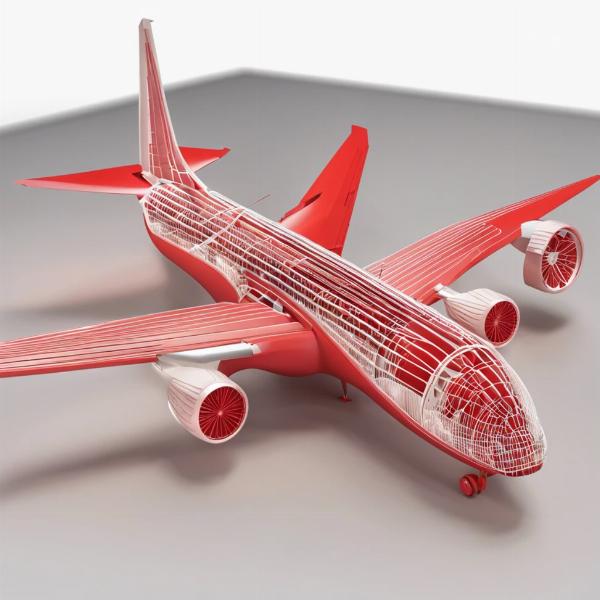Aerospace 3D Printing Market: Print, Fly, and Conquer the Skies!

Strong 8k brings an ultra-HD IPTV experience to your living room and your pocket.
Aerospace 3D Printing Market: Revolutionizing Multiple Sectors
The Aerospace 3D Printing Market is not just revolutionizing how aircraft and spacecraft are built it’s reshaping entire industries. With a market size of USD 1.91 billion in 2022 and projected to reach USD 6.50 billion by 2030, this sector is experiencing a compound annual growth rate (CAGR) of 14.64%. Such growth demonstrates the critical role that additive manufacturing, or 3D printing, is playing in improving efficiency, reducing costs, and pushing the boundaries of innovation in aerospace. This article dives into the multi-sectoral impact of Aerospace 3D Printing, exploring its profound influence on the economy, industries, consumers, and future technologies.
The Aerospace 3D Printing Market: Key Players and Drivers
Major players in the Aerospace 3D Printing market include Stratasys, 3D Systems, Arcam Group, Renishaw, GE Additive, and EOS e-Manufacturing Solutions. These companies have pioneered groundbreaking technologies that streamline production processes, particularly in civil aviation, military aviation, and spacecraft manufacturing. The use of 3D printing materials ranging from plastics and ceramics to metals has reduced manufacturing lead times while allowing for customization that would have been impossible with traditional methods.
Market Expansion of The Aerospace 3D Printing Market
North America is the largest contributor to the Aerospace 3D Printing market, with a significant presence of aircraft manufacturers and leading technology companies. Europe and Asia Pacific follow closely, driven by increased aerospace investments and government support. These regions are investing heavily in research and development to stay competitive in a market that promises both economic and strategic advantages.
Civil Aviation: Enhanced Efficiency and Sustainability
Streamlined Manufacturing and Cost Reduction
In civil aviation, the integration of 3D printing has simplified the manufacturing process by reducing the number of parts needed for complex assemblies. For instance, GE Additive has employed 3D printing to create fuel nozzles that are 25% lighter and five times more durable than traditional versions. These nozzles are also built from one part, reducing the need for multiple components, assembly, and inspections.
Lighter, More Efficient Aircraft
By using 3D-printed parts, aerospace manufacturers are achieving significant weight reductions. Lighter aircraft use less fuel, thereby reducing operational costs and environmental impact. This aligns with the industry's growing focus on sustainability, where reducing the carbon footprint is critical. A recent report from Airbus suggests that the company has reduced waste by 30% and improved fuel efficiency through 3D printing technologies.
Supply Chain Transformation
Civil aviation has also seen changes in its supply chain, where on-demand printing has eliminated the need for large inventories of spare parts. Companies can now print components as needed, reducing storage costs and minimizing downtime. This shift to just-in-time manufacturing has saved companies millions and accelerated maintenance and repair operations.
Military Aviation: A New Frontier in Customization and Resilience
1.Rapid Prototyping for Custom Solutions-
In military aviation, the ability to rapidly prototype custom components is a game-changer. Stratasys and SLM Solutions have provided defense contractors with the ability to produce prototypes and test models faster than ever before, enabling the military to deploy cutting-edge technology at unprecedented speeds. The U.S. Air Force recently utilized 3D printing to create fighter jet parts that had become obsolete, ensuring that its aircraft can remain operational for decades longer.
2.Improved Resilience and Reduced Maintenance-
For the military, 3D printing is also crucial in creating spare parts for aircraft in remote locations. By deploying portable 3D printers, the military can produce necessary components in the field, reducing the need for large, vulnerable supply chains. This increased resilience means fewer grounded aircraft and more operational readiness in unpredictable environments.
Spacecraft: Expanding the Possibilities of Space Exploration
Building Lighter, More Durable Spacecraft
In the space sector, 3D printing is helping to reduce the costs of launching payloads. Companies like SpaceX and NASA have adopted 3D printing to create lightweight, durable spacecraft components. Reducing the weight of a spacecraft directly impacts the cost of launching it into orbit, saving millions of dollars per launch. NASA’s Mars Rover, for instance, features multiple 3D-printed parts that are critical to its long-term mission durability.
Experimenting with 3D Printing in Space
The potential of 3D printing extends far beyond Earth’s atmosphere. Made In Space, a company working with NASA, has developed a 3D printer that works in zero gravity, enabling astronauts to produce tools and spare parts on the International Space Station (ISS). This capability drastically reduces the need to send additional supplies from Earth, making long-term space exploration more feasible.
Accelerating the Colonization of Other Planets
Looking ahead, 3D printing may play a vital role in building habitats on the Moon or Mars. Companies like ICON are developing systems that could one day use regolith, the loose soil found on the lunar and Martian surfaces, as material for 3D-printed buildings. This could be pivotal in sustaining human life in extraterrestrial environments.
Impact on Consumers: Bringing Aerospace Technology to Everyday Life
1.Affordable Air Travel
The advancements in Aerospace 3D Printing are contributing to more affordable air travel for consumers. As companies reduce manufacturing and maintenance costs, these savings may eventually trickle down to ticket prices. Furthermore, the lighter, more fuel-efficient aircraft reduce fuel consumption, further decreasing operational expenses.
2.Faster Delivery Services
As drones and autonomous aircraft become more prevalent, 3D printing technology could enable quicker, more affordable manufacturing of these delivery systems. This could revolutionize logistics, allowing for same-day deliveries in more remote areas and reducing shipping costs for consumers.
3.Personal Use of Aerospace Technology
On a smaller scale, consumers are also seeing the benefits of aerospace-grade 3D printing technologies in their everyday products. Companies like Tesla are incorporating aerospace-grade 3D-printed parts into electric vehicles, making them lighter and more efficient. Additionally, athletic equipment and wearable technology manufacturers are beginning to use aerospace materials to create custom-fit products that are both durable and lightweight.
Statistics and Forecasts: The Future of Aerospace 3D Printing
The future of Aerospace 3D Printing is bright, with the market projected to reach USD 6.50 billion by 2030, growing at a 14.64% CAGR. The rapid adoption of 3D printing across various aerospace sectors will likely accelerate this growth as companies continue to innovate and expand. The civil aviation sector, in particular, is expected to lead the charge, followed by military aviation and spacecraft applications.
North America will continue to dominate the market, thanks to its strong manufacturing base and advanced R&D initiatives. However, Asia Pacific is expected to see the fastest growth, driven by increasing investments in aerospace infrastructure and government support for technological innovation.
Challenges and Opportunities OF 3D Printing Market
Despite its numerous benefits, Aerospace 3D Printing still faces some challenges. The high initial investment and the need for qualified engineers with specialized knowledge of 3D printing technologies remain barriers to widespread adoption. Additionally, regulatory hurdles must be overcome, as aerospace components must meet stringent safety and reliability standards.
However, these challenges also present opportunities. As the technology matures, costs will decrease, and training programs will equip the next generation of engineers with the skills needed to harness the full potential of 3D printing. Governments and companies alike are investing heavily in research and development, ensuring that the technology continues to evolve.
Future Trends in the Aerospace 3D Printing Market
As 3D printing technology continues to evolve, several key trends are expected to shape the future of the aerospace 3D printing market:
1. Expansion of Material Options
One of the most exciting developments in the aerospace 3D printing market is the expansion of material options. Researchers are exploring new materials, such as advanced composites and high-temperature ceramics, that can be used in 3D printing to create even stronger and lighter aerospace components. These materials could unlock new possibilities for aircraft design and performance.
2. Increased Use in Space Exploration
3D printing is playing an increasingly important role in space exploration. NASA and private space companies like SpaceX are already using 3D printing to manufacture parts for rockets and satellites. In the future, 3D printing could enable the production of spacecraft components in space, reducing the need for costly supply missions and allowing for greater self-sufficiency in space exploration.
3. Automation and AI Integration
The integration of artificial intelligence (AI) and automation with 3D printing is expected to drive further advancements in the aerospace industry. AI-powered 3D printers can optimize print parameters, reduce human error, and improve the quality and consistency of printed parts. Automation will also streamline production processes, allowing for faster and more efficient manufacturing of complex aerospace components.
4. Sustainability and Green Manufacturing
Sustainability is becoming a key focus in aerospace manufacturing, and 3D printing is well-positioned to contribute to greener production methods. By reducing material waste, energy consumption, and carbon emissions, 3D printing supports the aerospace industry’s goals of reducing its environmental impact. In the coming years, we can expect to see more emphasis on using 3D printing to create sustainable and eco-friendly aircraft components.
Conclusion: A Catalyst for Change Across Industries
The Aerospace 3D Printing market is much more than a niche industry—it is a catalyst for change across multiple sectors. From transforming civil aviation to military operations and space exploration, 3D printing is reducing costs, improving efficiency, and unlocking new possibilities for innovation. As the market continues to grow, its influence will be felt not only in aerospace but in the daily lives of consumers, bringing the benefits of advanced manufacturing technologies closer to home. Despite the challenges, such as material certification and high initial costs, the long-term benefits of 3D printing in aerospace far outweigh the obstacles. Companies that invest in this technology now will be well-positioned to lead the industry in the coming years, as 3D printing becomes an integral part of the aerospace supply chain. As innovation in aerospace continues to soar, 3D printing will undoubtedly play a central role in shaping the future of flight.
Note: IndiBlogHub features both user-submitted and editorial content. We do not verify third-party contributions. Read our Disclaimer and Privacy Policyfor details.







